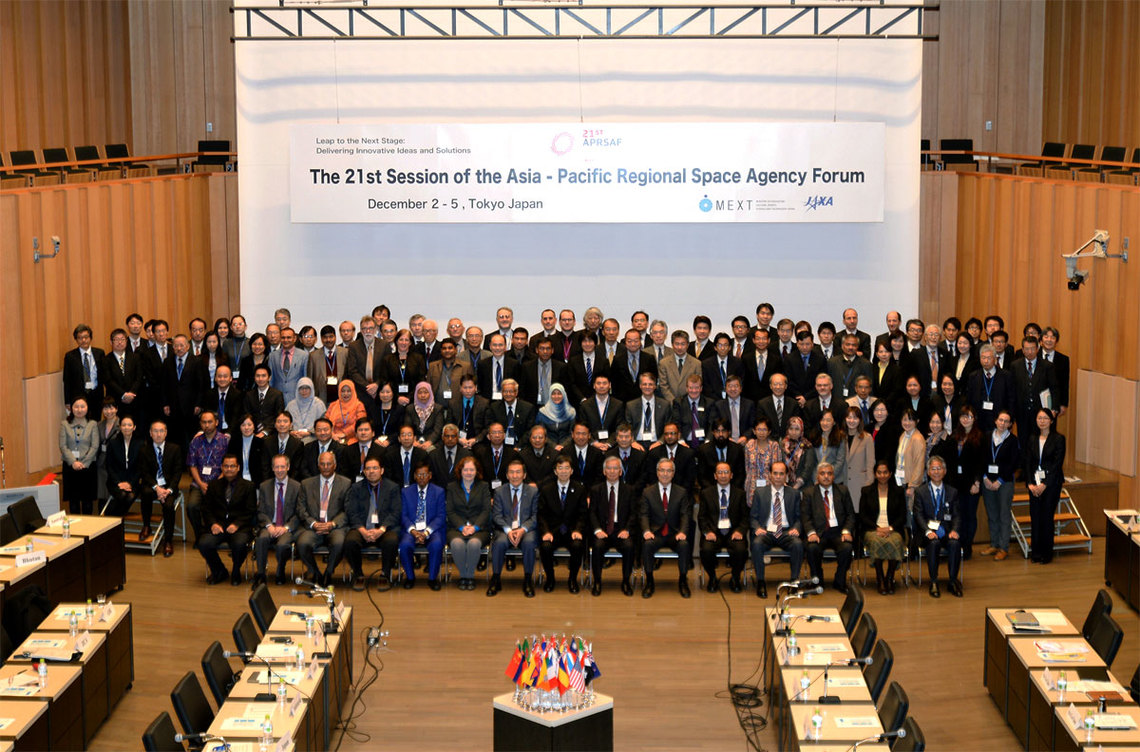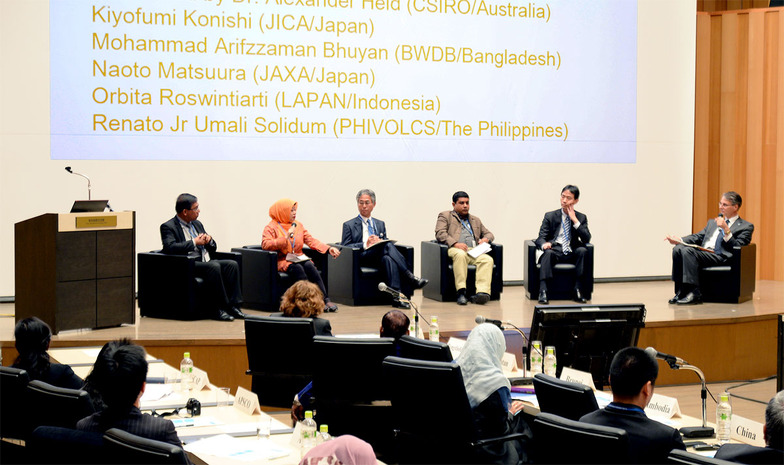The 21st Asia-Pacific Regional Space Agency Forum (APRSAF-21) Held in Japan for the First Time in 9 Years Special Session Report
The 21st Asia-Pacific Regional Space Agency Forum (APRSAF), aimed at promoting the use of space technology in the Asia-Pacific region, was held over four days from December 2nd at the National Museum of Emerging Science and Innovation (Miraikan) and the International Exchange Hall in Koto Ward, Tokyo. Co-hosted by the Ministry of Education, Culture, Sports, Science and Technology (MEXT) and the Japan Aerospace Exploration Agency (JAXA), this report covers the special sessions "Social Needs and Practical Space Utilization" and "The International Space Station and Beyond."

Reports on the status of space technology utilization and mutual cooperation in each country
In Special Session 1, titled "Social Needs and Practical Space Utilization," moderated by Alexander Held of the Commonwealth Scientific and Industrial Research Organisation (CSIRO) of Australia, panelists representing relevant organizations from various countries reported on current initiatives from the perspective of how space exploration technology and its applications can meet social needs.
The following five individuals served as panelists.
・Mr. Atsufumi Konishi, Senior Advisor, Japan International Cooperation Agency (JICA)
Mohamed Arifzaman Boyan, Bangladesh Water Resources Development Authority
・Mr. Naoto Matsuura, Director, Satellite Utilization Promotion Center, JAXA (Japan Aerospace Exploration Agency)
・Orbita Roswintarti, National Institute of Aeronautics and Space, Indonesia
・Renato Umari Solidam, Philippine Institute of Volcanology and Seismology

Mr. Konishi of JICA (Japan International Cooperation Agency) reported on recent examples of utilizing space technology in ODA (Official Development Assistance) for developing countries. He cited examples such as "Research on Himalayan Glacial Lake Outburst Floods" in Bhutan, "Wide-area Assessment of Carbon Dynamics in Amazonian Forests" in Brazil, and "Enhancing Earthquake and Volcano Monitoring Capabilities and Promoting the Utilization of Disaster Prevention Information" in the Philippines, emphasizing the importance of utilizing space technology for the sustainable growth of developing countries.
Mr. Bouyan from Bangladesh introduced environmental management initiatives using remote sensing technology. With 92% of Bangladesh's land area being river basins, flood control is the most critical challenge. The Water Resources Development Authority combines data from Japan's JAXA GSMaP (Global Satellite Map of Precipitation) with ground-based rain gauge data to generate flood information. This information is communicated to local residents via short message service (SMS) and utilized for adjusting crop planting schedules and guiding evacuations during floods. Mr. Boyan emphasized that in Bangladesh, where the use of space information is still in its infancy, acquiring the latest technology and training engineers are urgent priorities, appealing for cooperation from APRSAF member countries.
Mr. Matsuura of JAXA reported on the utilization of data from the Advanced Land Observing Satellite-2 (ALOS-2), launched in May 2014. JAXA's GSMaP provides global rainfall distribution reports by integrating data from multiple satellites, delivering this information approximately four hours after observation. Matsuura stated the goal is to reduce this four-hour delay to 1.5 hours in the near term and eventually provide near real-time data. He also emphasized that countries should possess geostationary satellites capable of obtaining high-precision data on vegetation, atmospheric, and surface temperatures, similar to Japan's Himawari weather satellites, and combine and utilize this information.
Mr. Matsuura also mentioned JAXA's international human resource development activities. Through international projects like "Sentinel Asia" (monitoring natural disasters in the Asia-Pacific region) promoted by APRSAF, JAXA has accepted approximately 160 trainees from Asian countries to date, providing specialized technical guidance. Mr. Matsuura expressed his aspiration: "We intend to continue capacity development activities, collaborating with JICA for countries requiring financial assistance."
Roswinta Arti, a participant from Indonesia, introduced her country's "Drought Monitoring System." Indonesia, particularly Java, has experienced severe droughts in the past, caused by phenomena like El Niño, resulting in significant damage to crops. Indonesia's National Institute of Aeronautics and Space (LAPAN) and Ministry of Agriculture have developed a drought prediction model using remote sensing technology, capable of forecasting drought conditions up to six months in advance. This model is utilized for decision-making in agricultural operations. Roswinta Arti emphasized that, in addition to approaches from hydrometeorology—which studies water sources and disasters based on atmospheric and rainfall conditions—addressing the recent and particularly concerning issue of deforestation is also an urgent priority.
Mr. Solidam from the Philippines presented multiple case studies from the Sentinel Asia project conducted jointly with JAXA. Space technology has previously aided in building disaster damage databases and mitigating disasters through prediction and warning activities in some regions. Currently, its application has expanded nationwide and is also being used for monitoring volcanic activity. Mr. Solidam emphasized that "the speed of information is essential for disaster mitigation," highlighting the usefulness of space technology for this purpose. He strongly expressed his desire to continue contributing to protecting citizens' lives through mutual cooperation with APRSAF member countries.
Through the International Space Station, we want to share not only technology but also "dreams"
Special Session 2, titled "The International Space Station and Beyond: Toward International Space Exploration," introduced initiatives by Asian countries utilizing the International Space Station (ISS). Astronaut Soichi Noguchi, who became the first Asian president of the Association of Space Explorers (ASE) in September 2014, moderated the session. He discussed with Mr. Mohd Fairos Asliam from the Malaysian Space Agency and Mr. Kritsatchai Somasamorn from the National Science and Technology Development Agency of Thailand, both of whom participated in experiments aboard the Japanese Experiment Module "Kibo" on the ISS.

In Malaysia, space science research primarily relies on ground-based observations. Thailand lacks a dedicated space development agency. Against this backdrop, participating in the Kibo experiments appears to have brought a significant sense of accomplishment and expectation to space development personnel in both countries.
When asked by Noguchi, "What benefits has the ISS brought?", Asirum from Malaysia first stated, "The microgravity experiments conducted on Kibo offer new possibilities for our scientists and students," expressing hope that research and development, including the astronaut program, would advance to the next stage.
Meanwhile, Mr. Somasamorn of Thailand expressed high satisfaction with the results of the joint experiments, stating, "At Kibo, specialized space engineers supported us, allowing us to concentrate on our own research fields." He also shared his aspirations to undertake various experiments using his country's small Earth observation satellites in the future.
Mr. Somasamorn also shared examples of Thailand's active efforts in space education for young people. He described how high school students participated in experiments during parabolic flights (airplane flights creating a microgravity environment) with the cooperation of a British university, and how astronauts scheduled to board a U.S. private company's manned spacecraft gave lectures at elementary and junior high schools in Thailand. Through such activities, he expressed his dream, saying, "I hope this will lead to astronauts who will participate in the ISS in the future."
When asked by Mr. Noguchi about the roles both countries wish to play in future space development, Malaysia's Mr. Asirum stated his goal: to establish his country's space exploration technology within the decade starting 2015, nurture many scientists and engineers, and join the ranks of advanced nations. He added, "We want to use clean technology that considers space debris issues for future generations." He also stated, "We also want to focus on space exploration to protect Earth from threats like meteorites."
Meanwhile, Mr. Somasamorn from Thailand expressed two expectations. The first is collaboration with advanced space nations. "While our knowledge of space research is still limited, we can contribute through joint research with other countries in fields where cutting-edge research is advancing, such as medicine, robotics, nanotechnology, and agriculture," he stated with confidence. The second is business development using technologies derived from space exploration. "Space development holds promise for breakthroughs beyond existing knowledge. Examples of technologies developed by NASA include eyeglass coatings and infrared thermometers," he noted, adding that Thailand also aims to contribute in such business sectors.
Building on the discussion with both speakers, Noguchi highlighted astronaut exchanges transcending national borders and political stances. "Just as the Olympic torch is passed from hand to hand, let us connect and share not only information but also exciting 'dreams' from country to country, person to person, to realize a better future for humanity," he proposed, drawing loud applause from the audience.
Was this article helpful?